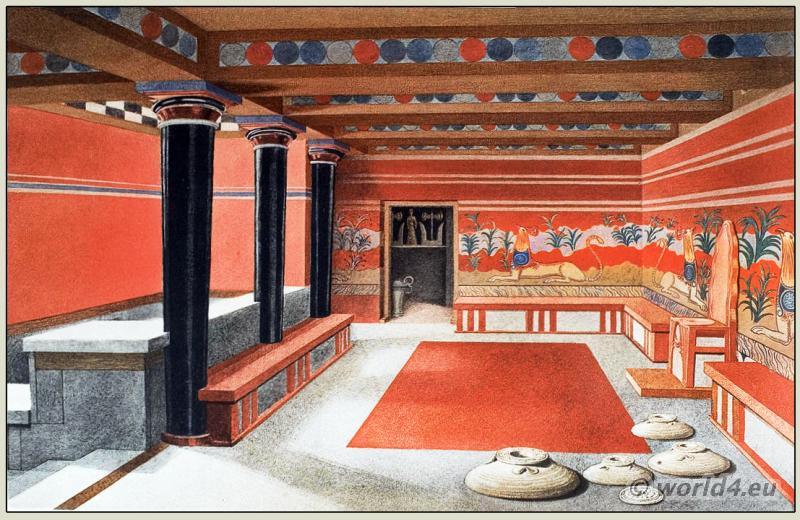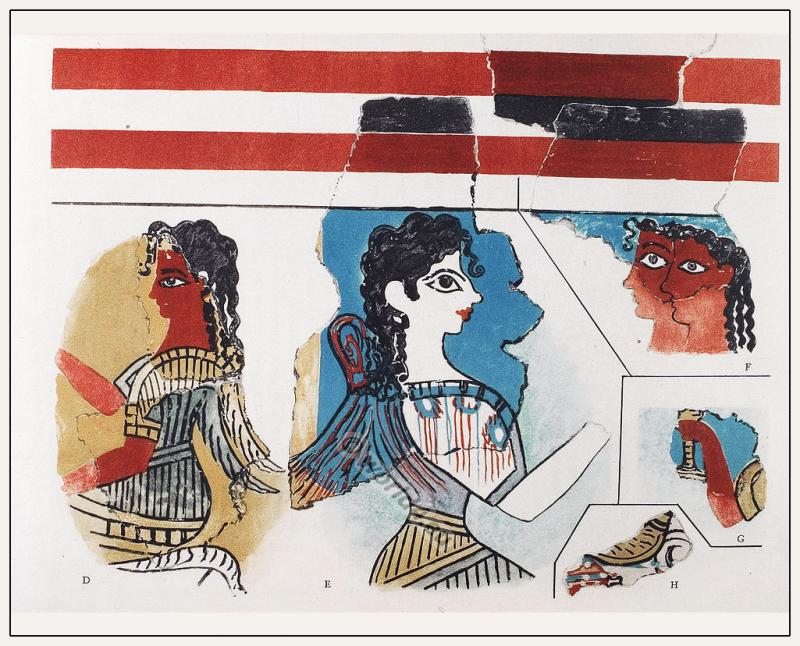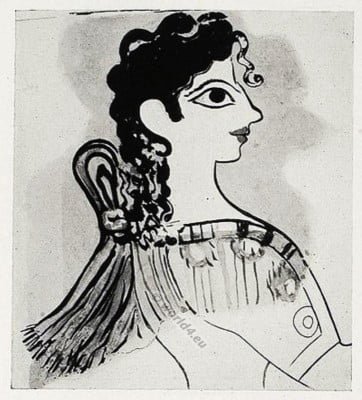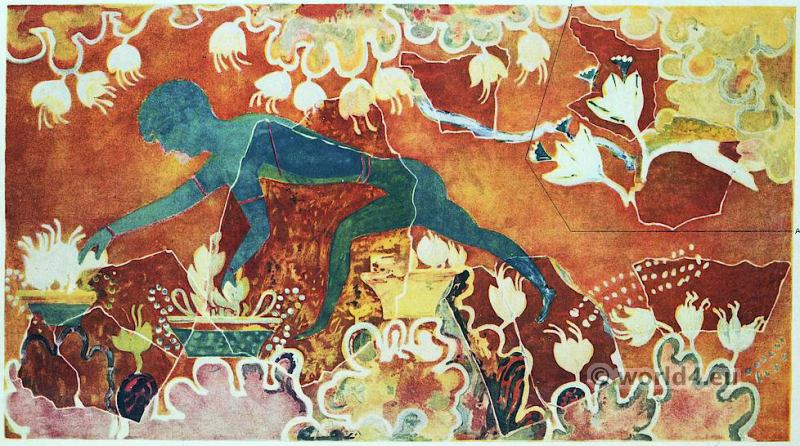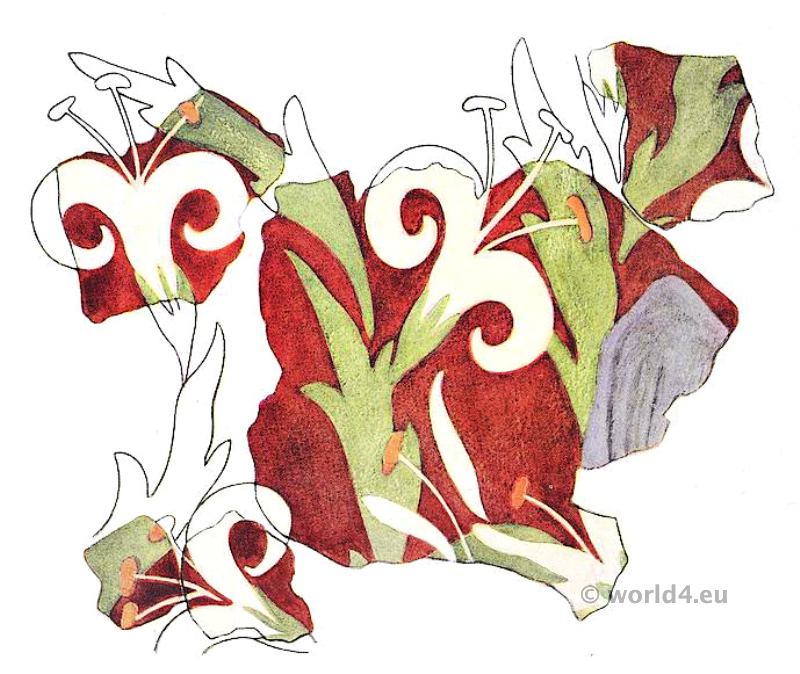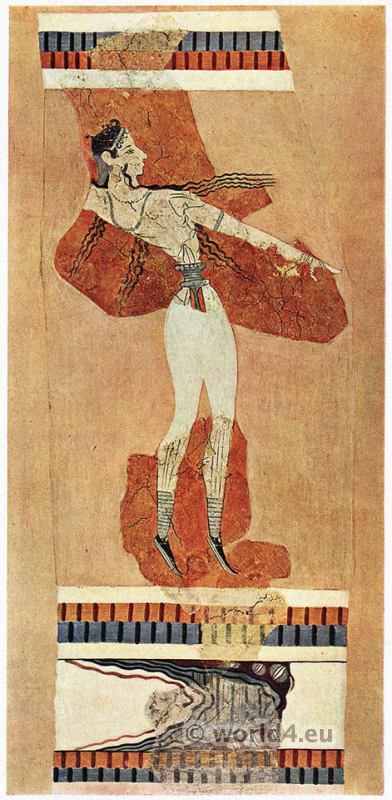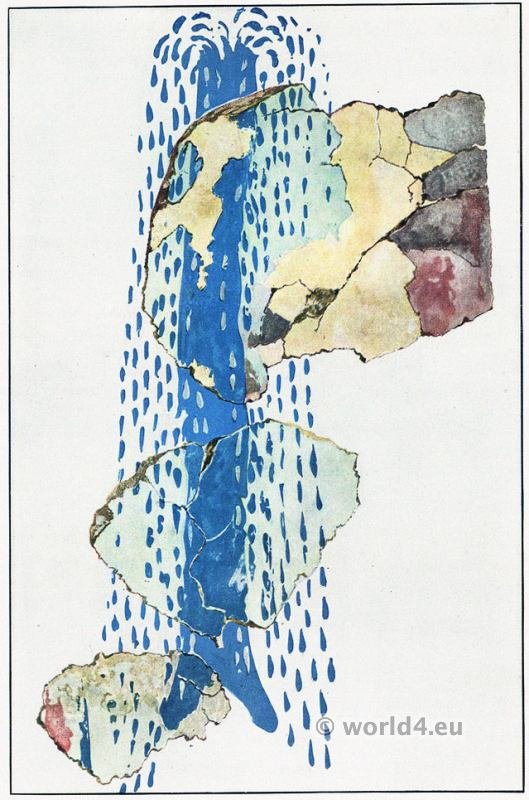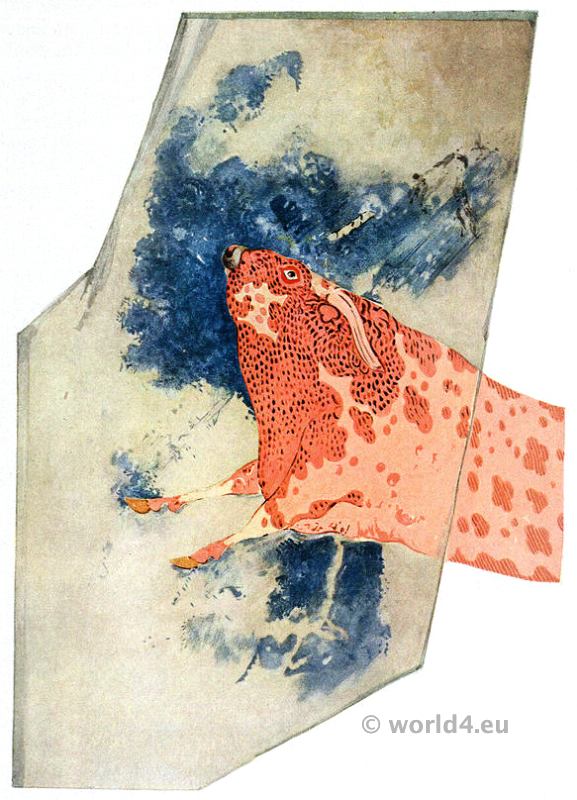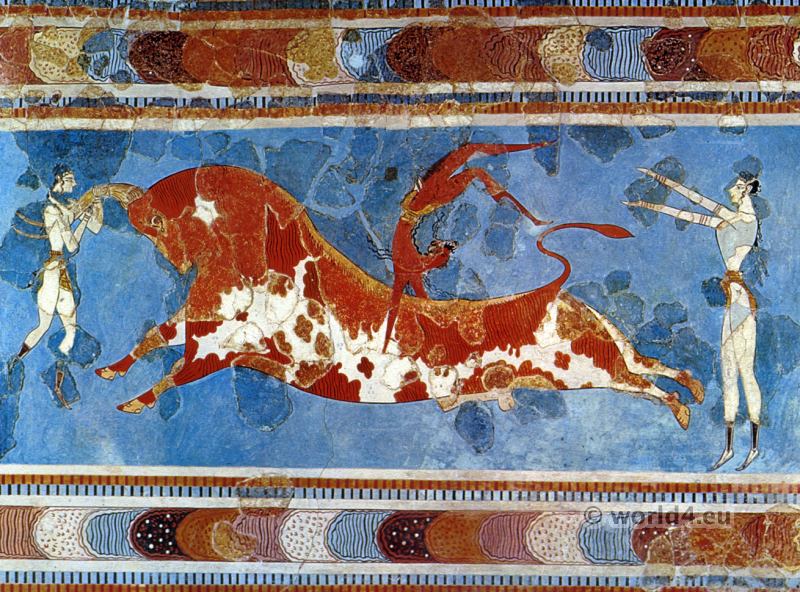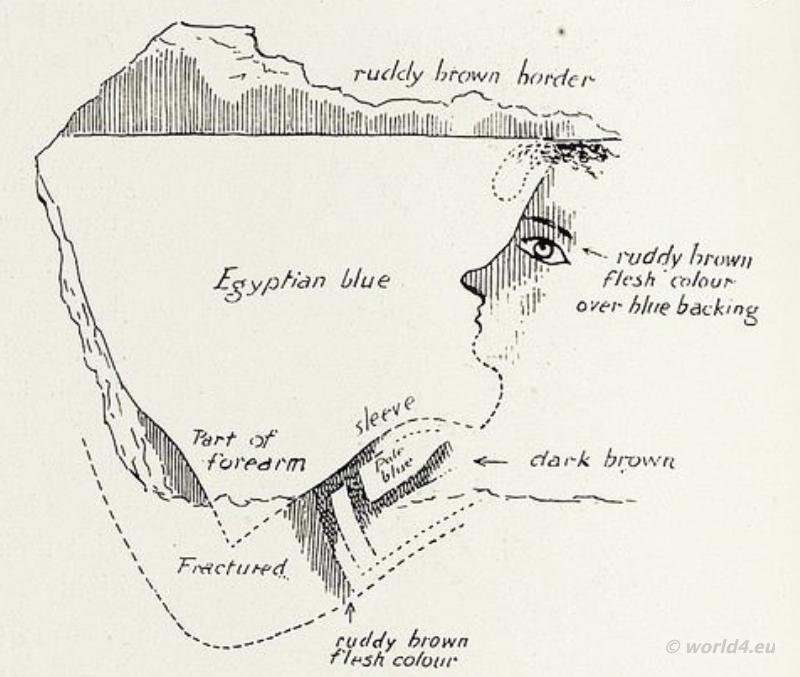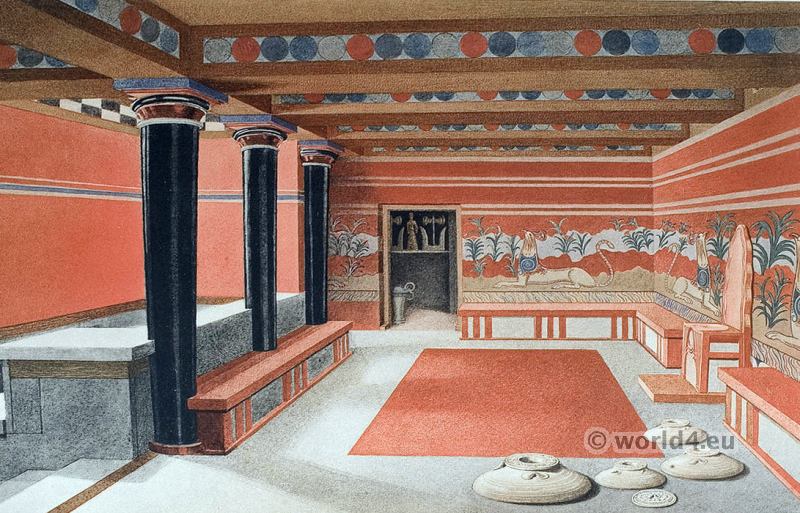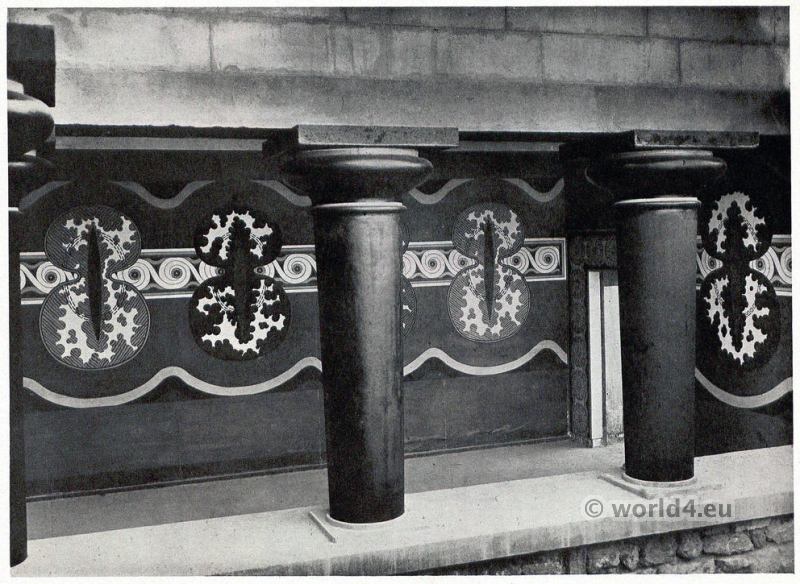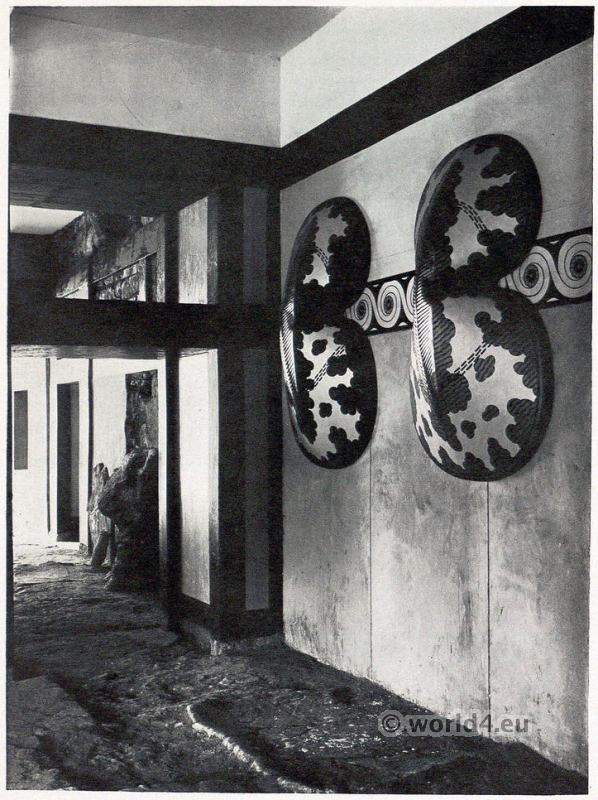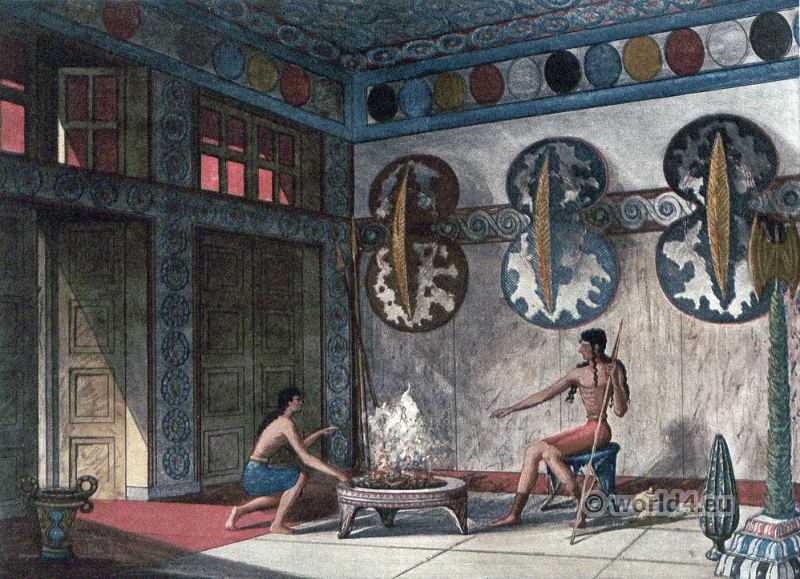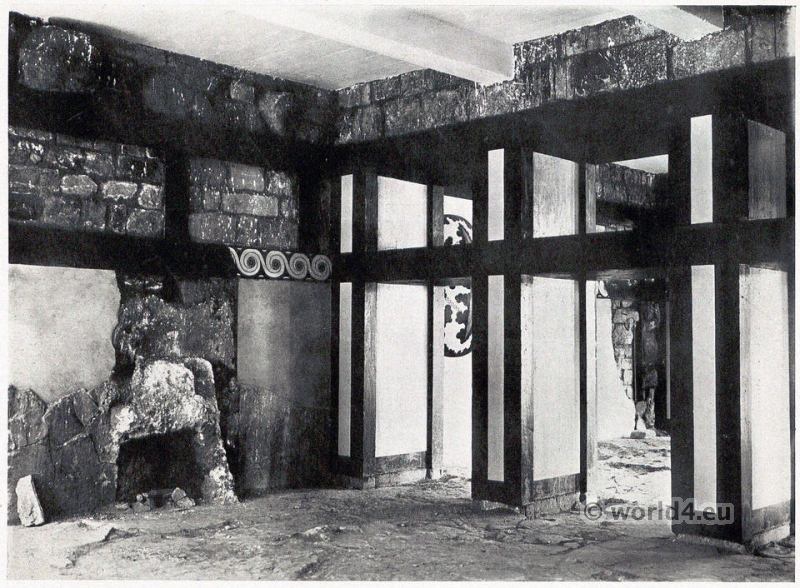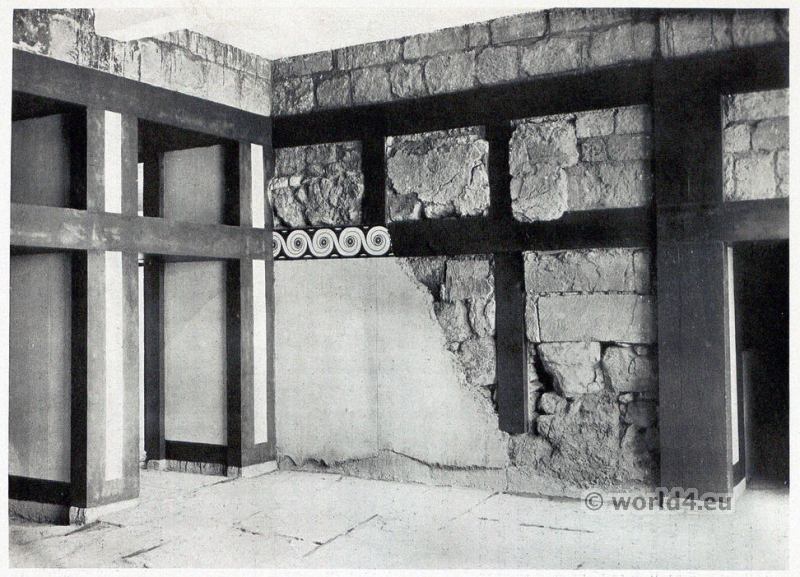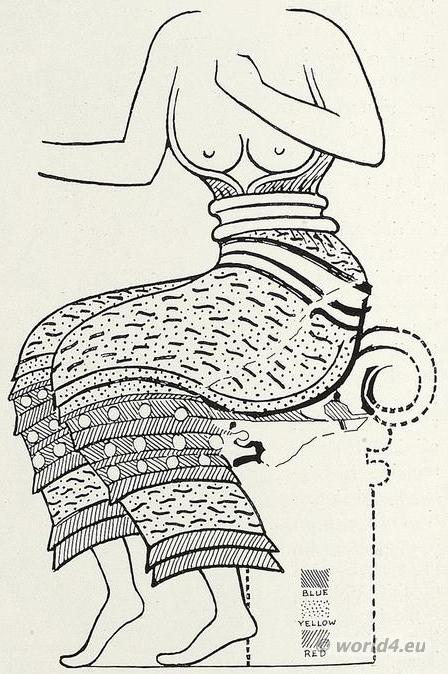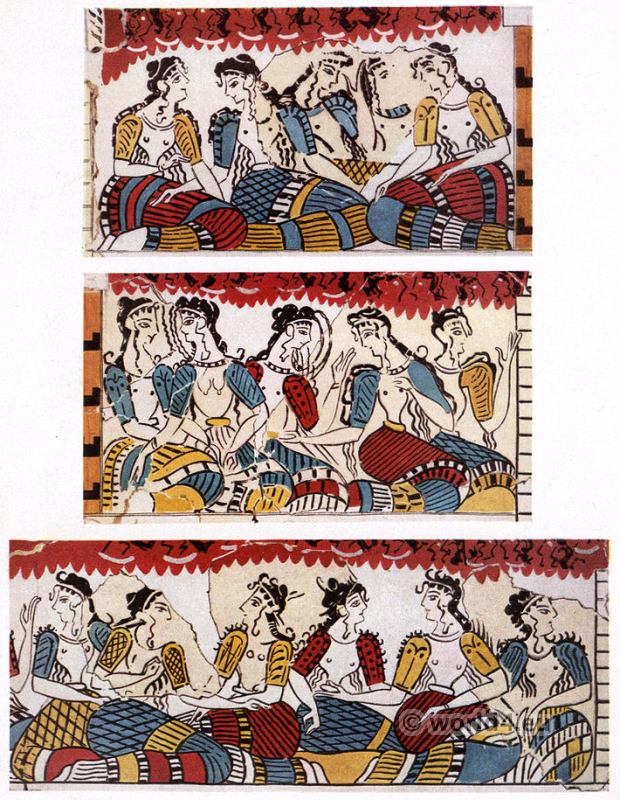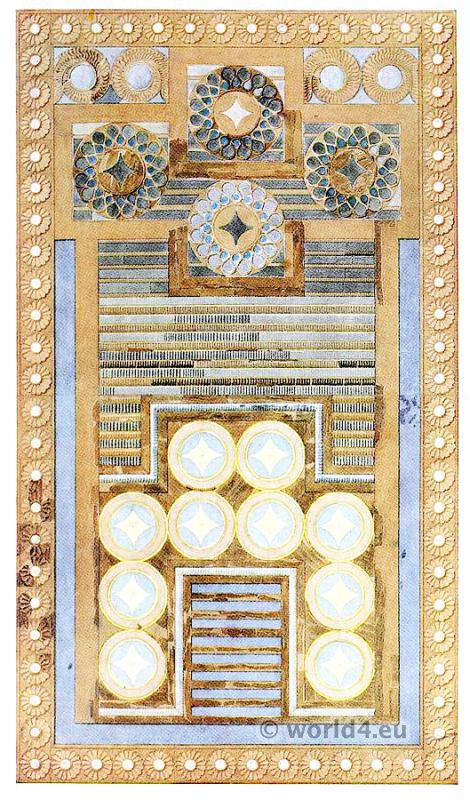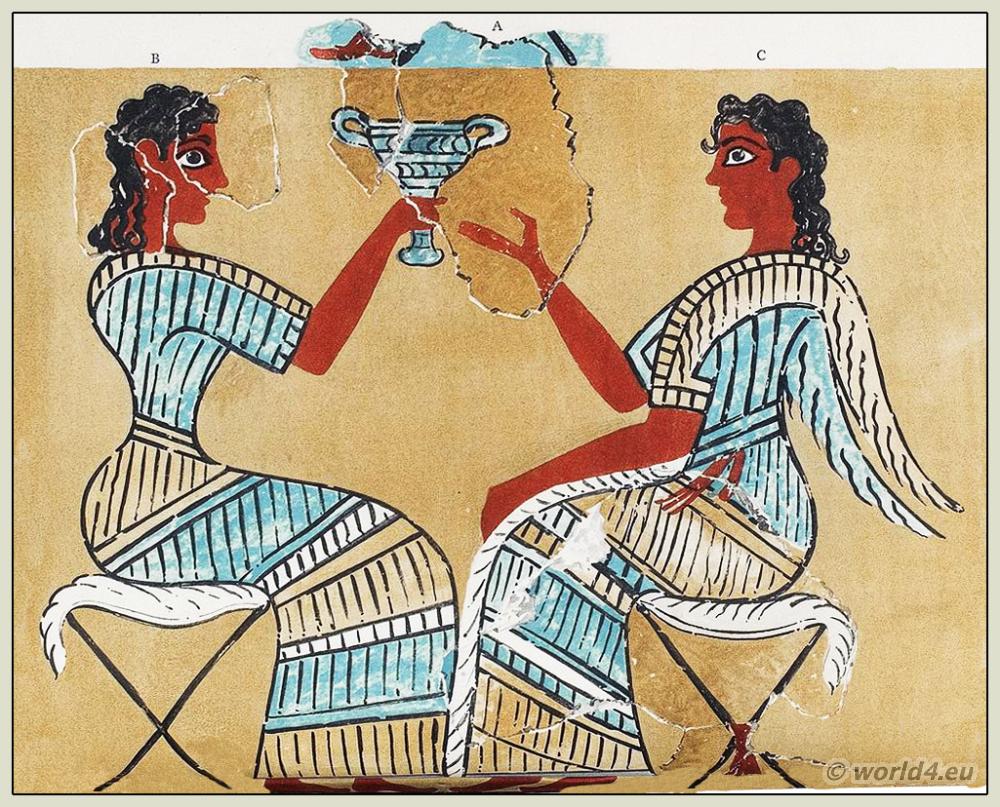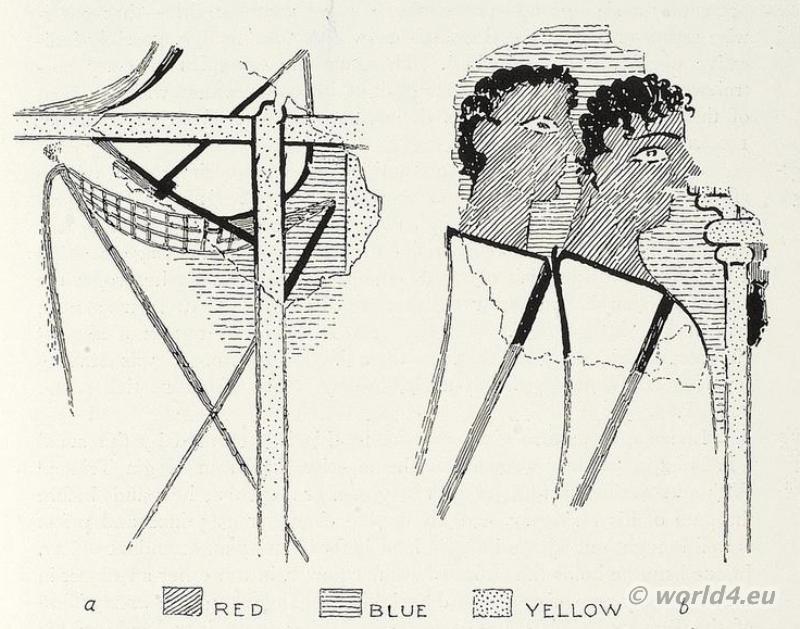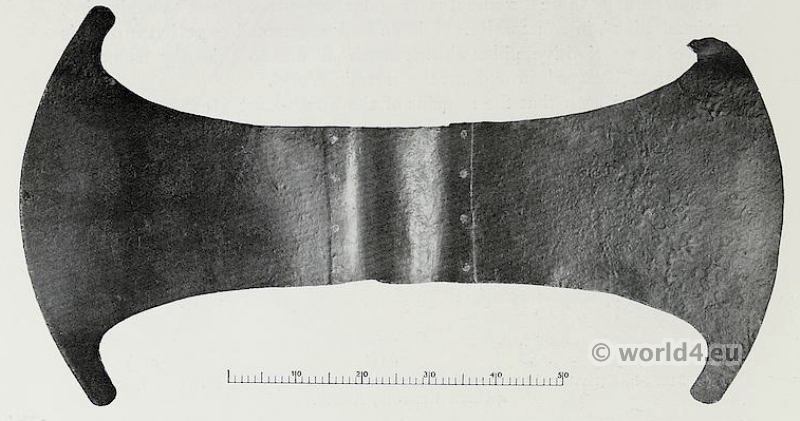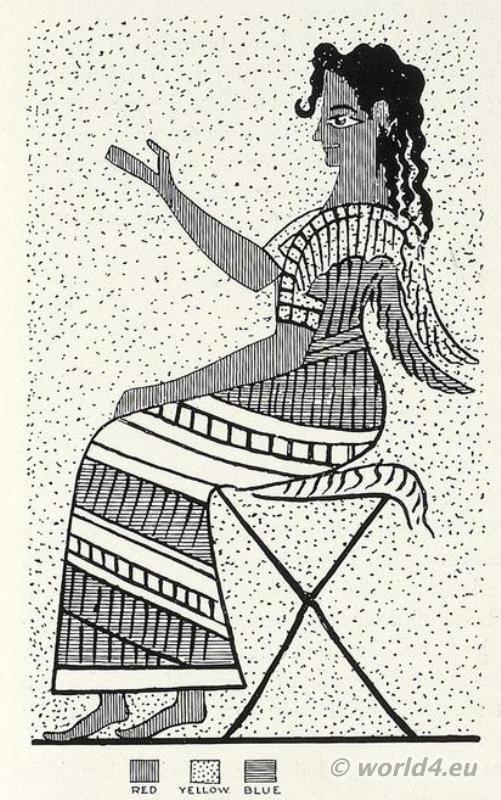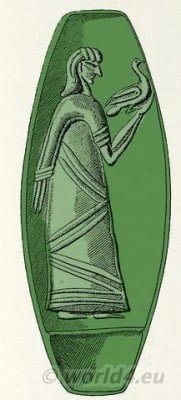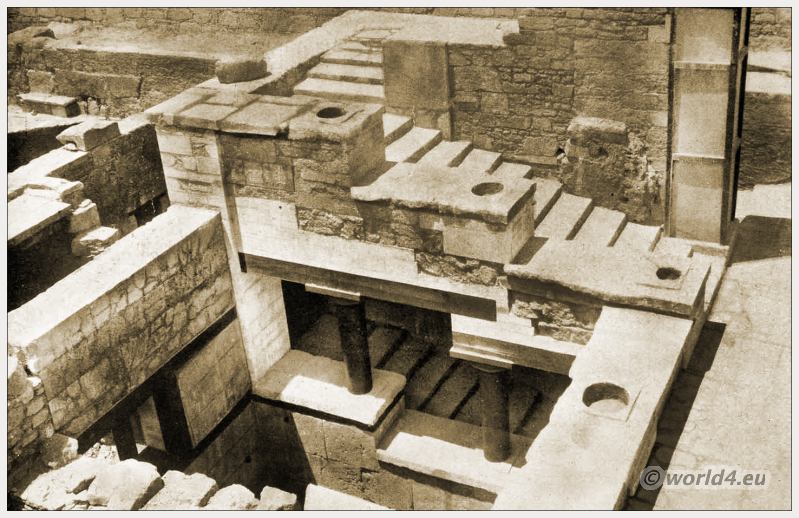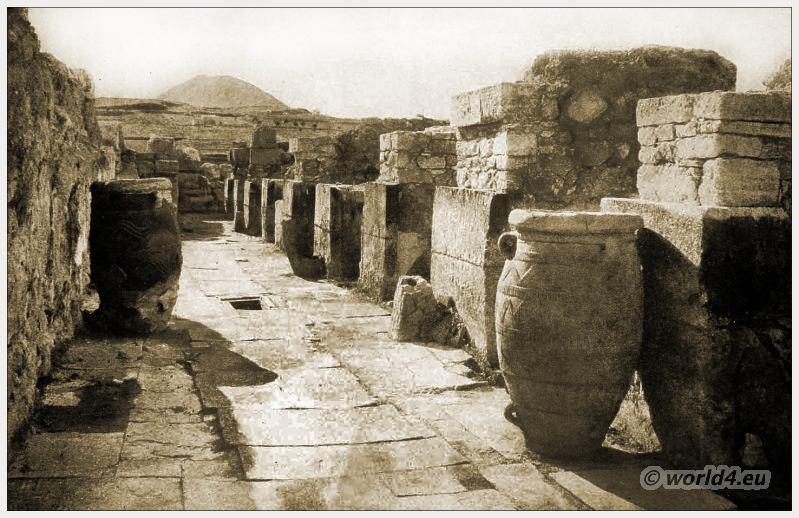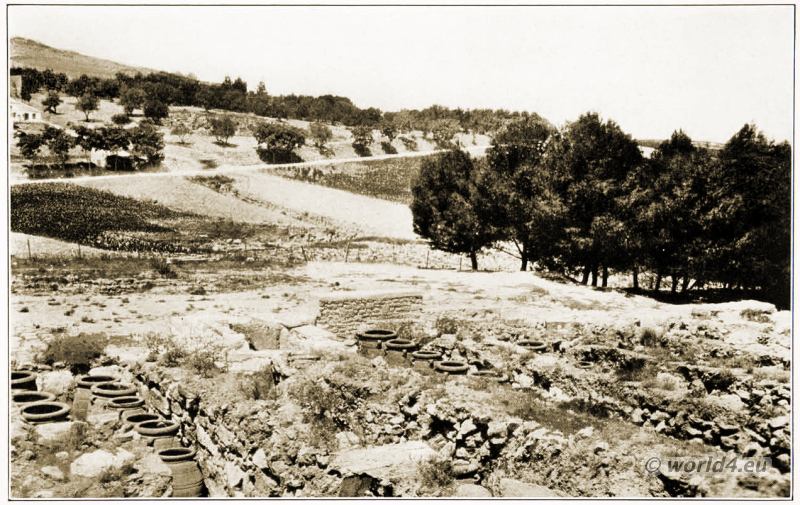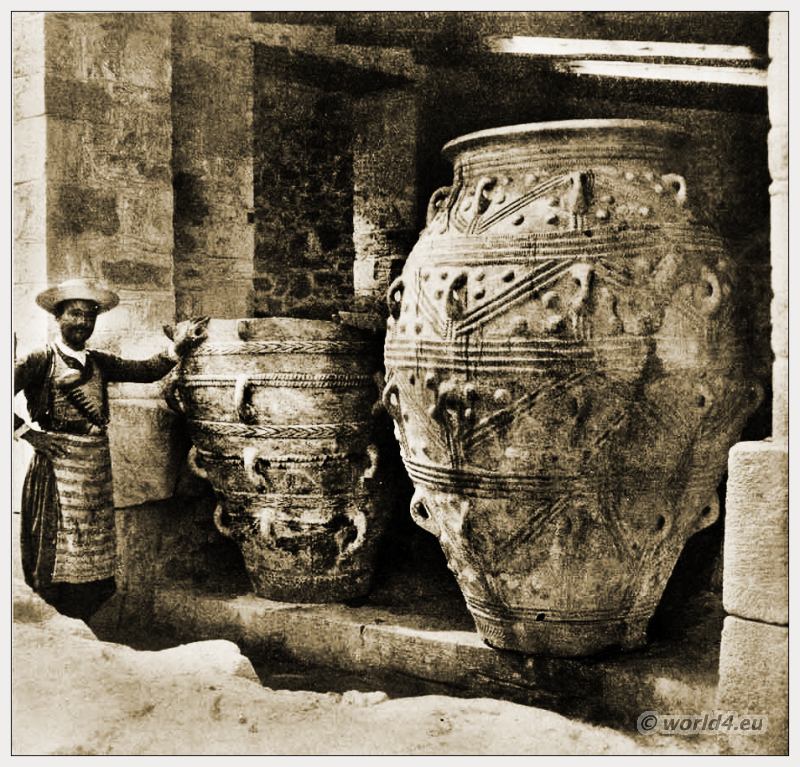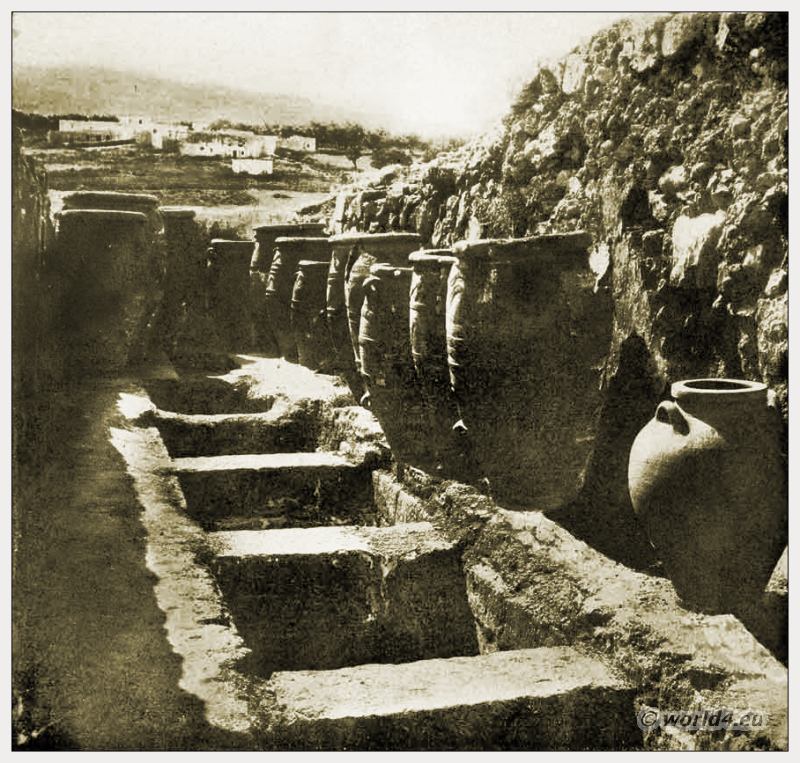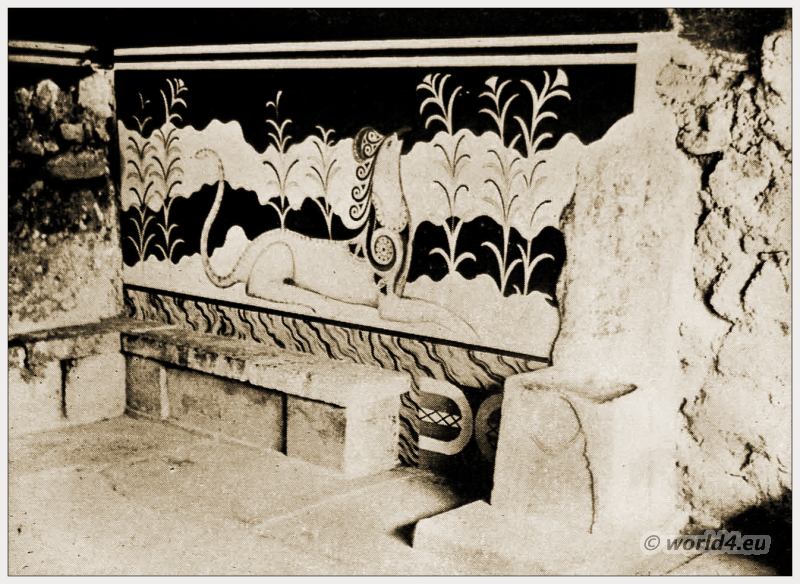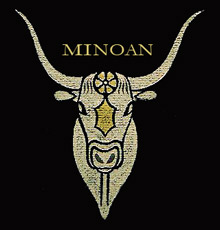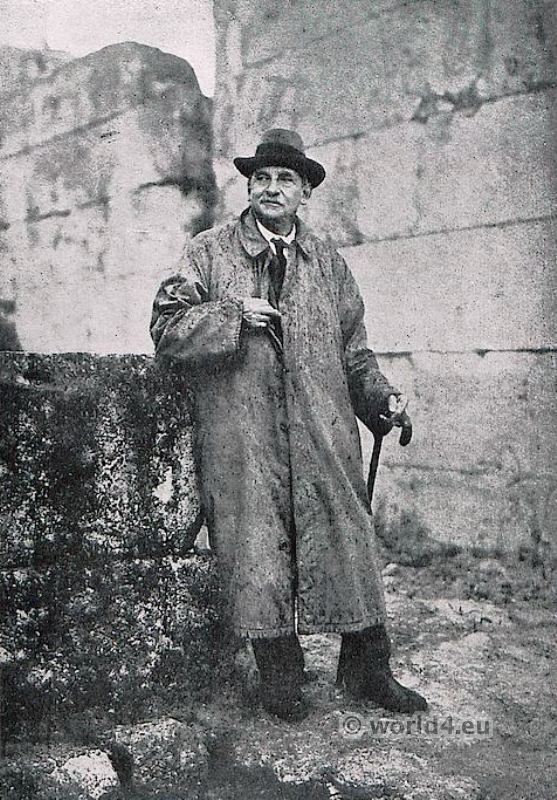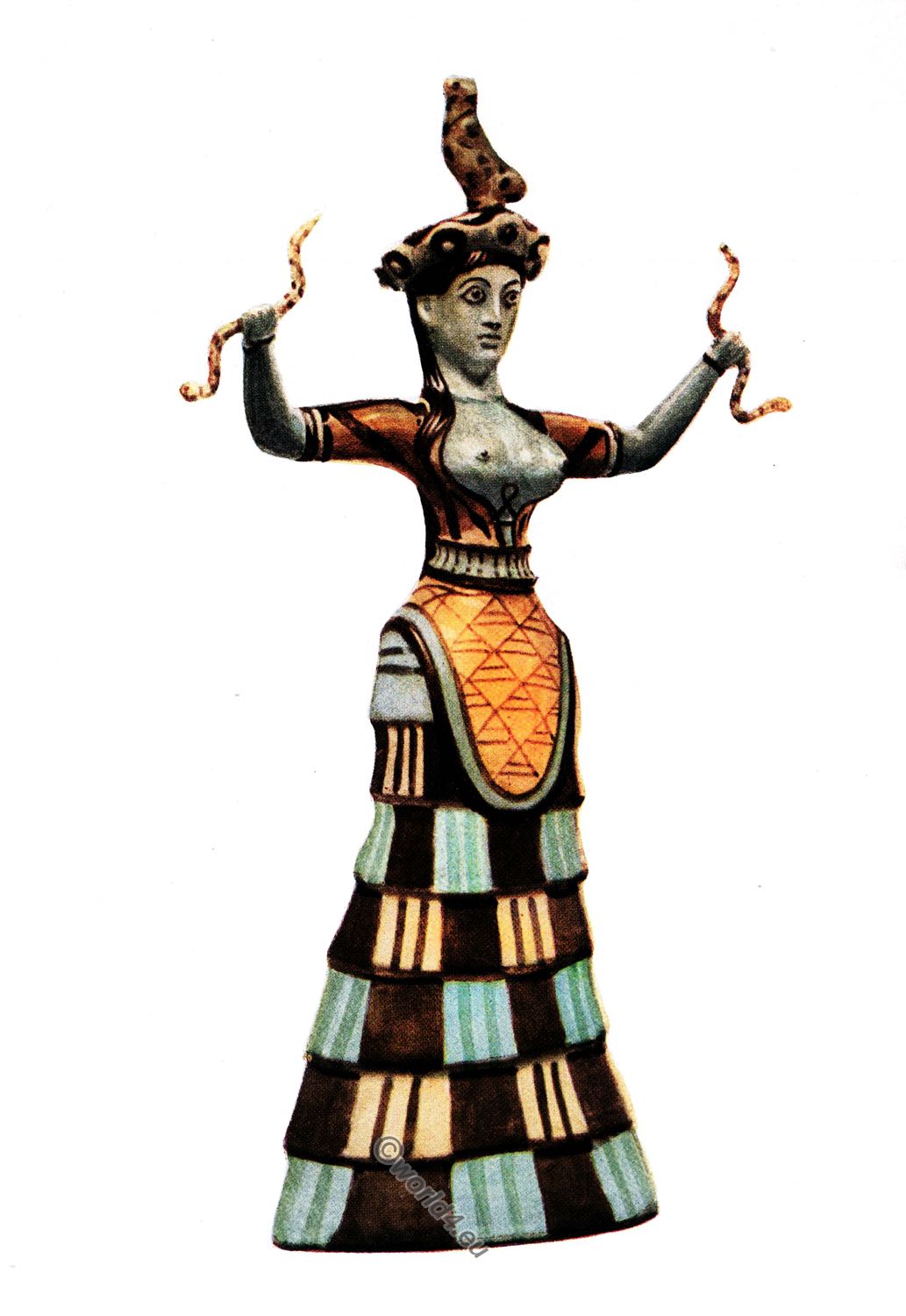The Minoan Costume. The Palace of Minos at Knossos. 1600 B.C.
LA PARISIENNE
From the long robes worn by most of the figures and their flowing hair, it might at first sight be supposed that they were of the female sex, but the red skin color is quite decisive in the matter, and they must be regarded as youth or boys. The smaller figure is clearly a young boy. The important fragment, E, however, from its white flesh color, is evidently a girl.
The heads of the figures with their staring eyes, the highly conventional hand of c, as well as the stiffly arranged pose and drapery, evidence a very crude style. The seated lady, E, indeed, here repeated in Fig. 319, has had a certain success in the modern world, and is often referred to as ‘la Parisienne’. Her elaborate coiffure and suspiciously scarlet lips are certainly marks of a highly artificial social life, such as we already have glimpses of in the Miniature Fresco of considerably earlier date depicting conversational groups of ladies in the front rows of the Grand Stand. But the figure before us, though not wanting in a certain picturesqueness, lacks the vivacity and individual characterization of the older group.
She is wearing a kind of scarf bunched up behind and tied in what from other analogies must be regarded as a ‘Sacral Knot’. Her highbodied dress shows a kind of broad sleeve, adorned with three fringed loops. It looks, indeed, as if the material were of a diaphanous texture, and that the light ground against which the blue and red frills are displayed should be taken for the white flesh color showing through. The wing-like excrescences that spring from the back of the seated boy, D of the companion group, differ from the ‘ Sacral Knots ‘ of the female figure. With the exception of these two features, however, there is a close agreement in the dress of the figures of both sexes. They are draped in long robes of an unwonted kind, reaching to the ankles.

The Saffron Gatherer Fresco. 
Painted Plaster with lily sprays. 
Part of Fresco Panel: Leaping girl from scene of Bull-Ring. 
Fountain (Jet D`Eau) from paited stucco panel, House of the Frescos. (Height c. 60cm.) 
Bull-Catching scene painted on back of crystal plaque 
The Partridge Fresco (Section 1 and 2). From Pavillion of “Caravanserai”. Restored drawing by E. Gilliéron. 
Bull-leaping fresco.
The Cretan, Minoan Costume
An era of great development, contemporaneous with the civilization of ancient Egypt and Phoenicia, and which may be dated about 2000-1500 B.C., had preceded the civilization that came from Asia Minor into Crete and Greece. Such fragments of Cretan culture as have come down to us reveal a beauty of technique and a delicate sense of form to which no contemporaneous civilization provides any parallel.
Owing to the lack of written records, the processes and methods of manufacture are still wrapped in obscurity, but although we are thus reduced to surmise regarding the materials used, the dress of that time is of the highest interest in view of its connexion with the costumes of other peoples. Our attention is especially attracted by the dress worn by the women. The slim, wiry figures of the men are clothed almost universally with a loincloth, richly patterned and splendidly decorated. Here and there we see wide cloaks that clothe the whole body, giving it a large appearance. Women also, it would seem, wore the short loincloth, but we find them wearing in addition skirts put together in an almost fantastic manner that betrays a highly developed knowledge of the technique of dressmaking. These skirts are constructed in tiers, separated by strips of rich ornamentation.
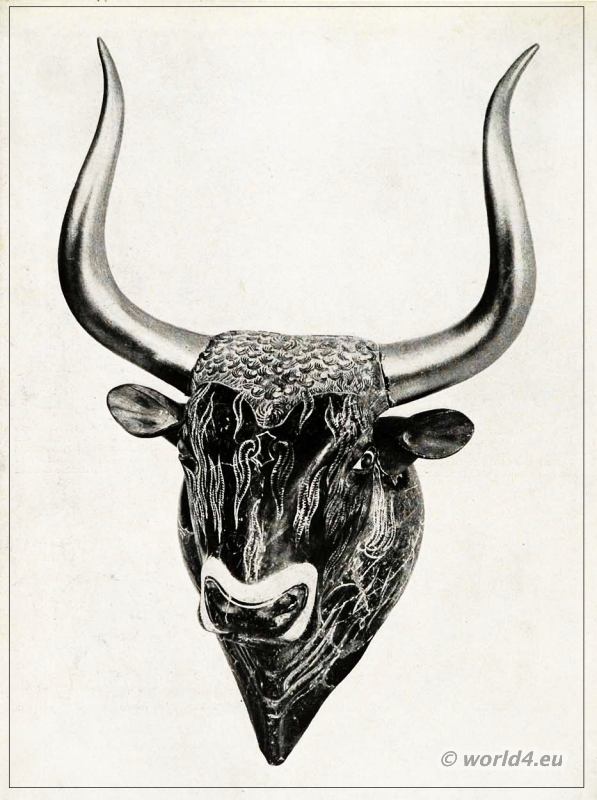
There are even examples of what are called volants, or flounces —i.e., narrow strips of patterned material, the upper projecting over the lower, and, if we are to judge from the perpendicular lines, disposed in fine accordion pleats. Over these falls a rounded kind of apron. The waist is slender, and surrounded by a rolled girdle. The upper part of the person is clothed in a sleeved jacket sewn at the shoulder, but the breast is bare. Considering the shape and the rich trimming of gold disks, it has been recently suggested that the material of these jackets was leather.
The headdress of these splendidly attired women is a turban-like roll of patterned material or a tall cap. The figures of women of the lower classes are clothed only up to the waist— i.e., they are without jackets. It has been surmised that the skirts consisted of several skirts, somewhat like aprons, which were worn one above the other, and which the wearer wrapped round her. More probably, however, they were bell-shaped garments of elastic material, woven or cut in a circular shape, such as are still worn by Thessalian peasant women. The bell-shape is always pronounced—wide at the foot, tapering quickly upward, and fitting tightly at the loins.
The jacket also was apparently close-fitting, giving no occasion for draping. These women, in their charming, elegant costume, are delineated for us on a number of mural paintings and seal impressions. These are full of interest. Even although we are still ignorant regarding the material of which the garments were made, we have good grounds for believing that the costumier’s art was highly developed in the Aegean zone of civilization around the Mediterranean Sea, including the Etruscan territories. Many of the mural tablets look like prehistoric fashion-plates. One of these dainty works of art shows a slender woman, dressed in a simple skirt, holding in front of her another highly ornamented skirt with diagonal stripes at the hips. Below these is a portion showing longitudinal folds, separated from the upper part by cross trimming. Round the part at the foot is a sort of volant, or flounce.
It is very evident that women’s dress played a great part in this civilization. Jewellery was just as highly developed. Gold buttons beautifully chased and showing leaves and animal figures, daintily wrought golden necklaces, etc., give us a hint of the luxury that prevailed. Technical skill is shown at its best in the necklets of granulated gold.
Just as perfect in their way as the jewellery of the women were the weapons of the men—of the lithe bull-fighter, the wrestler, the javelin-thrower, and the men who hunted the lion and the stag and guided their teams of galloping steeds.
By Karl Köhler
Men in short-sleeved jackets
This dress terminates above in short sleeves, recalling those of the usual female jackets, as seen on the figurines of the Goddess in the Temple Repositories and elsewhere. Similar short sleeves, indeed, appear on the forepart of a male personage seen on a painted stucco fragment in the South of the Palace (Fig. 320), and this element in costume was known, therefore, to Minoan Crete as well as to the Mainland regions, where it becomes general in Mycenaean Art.
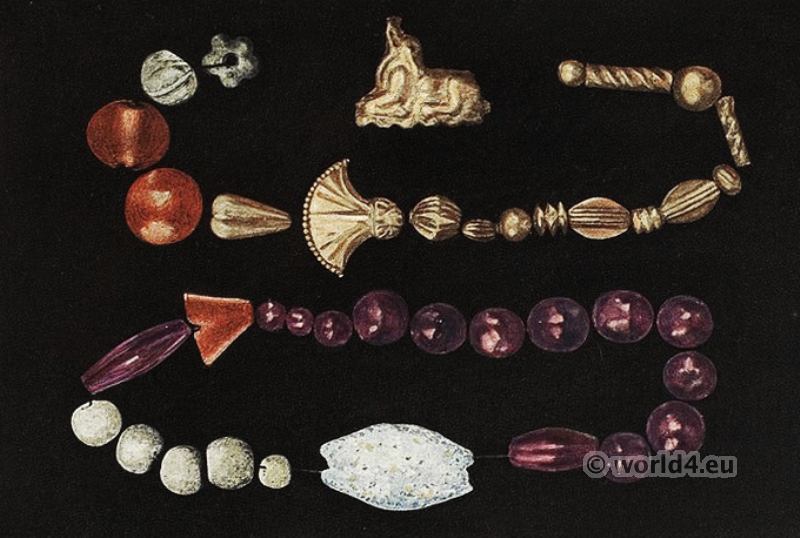
Simple bands here take the place of the usual close-fitting belts, and the long skirts are composed rather of broad diagonal bands than of flounces. Such a garb may well have been worn over the normal belt and loin-clothing of the men’s costume.
Taken as a whole, the costume has certainly a feminine appearance, and the assimilation of the dress in both sexes may be taken to have a ritual significance.
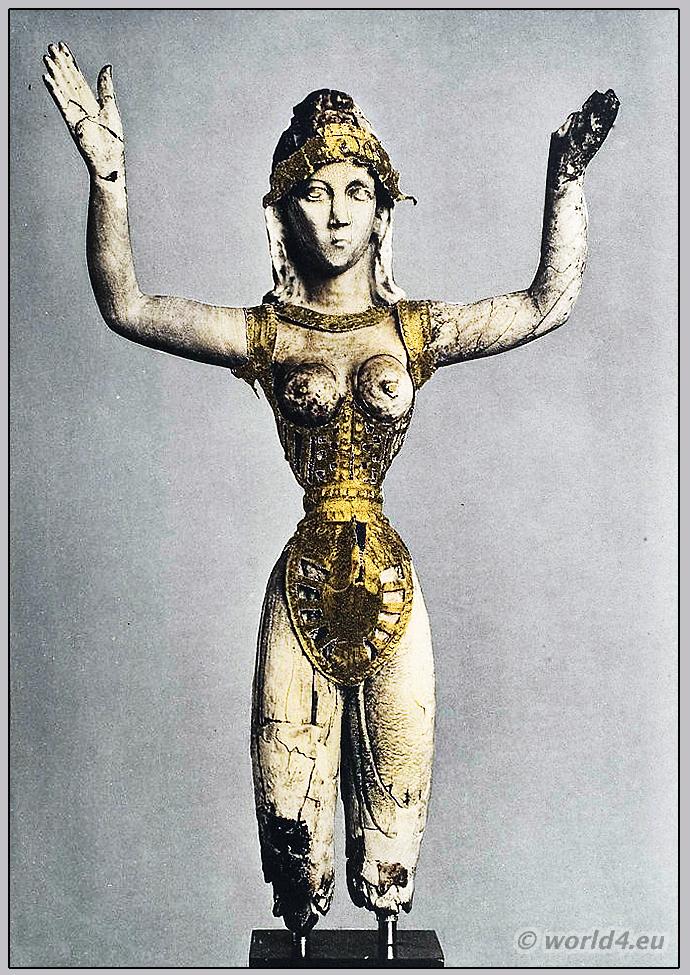
A parallel example has already been supplied in the case of the bull-sports of the Palace arena, where the girl performers attired themselves in the most characteristic articles of the men’s clothing, including the Minoan equivalent of the ‘ Libyan sheath ‘. So, too, the Goddess herself, as ‘Lady of the Sports’, is depicted in her chryselephantine image with her loins clad in the same male fashion as that adopted by the crirl performers.
Of the significance of these long robes as an evidence of the intrusion at this time of Syrian influences more will be said below.

“Room of the Throne” with frescoes and coloring restored: On pavement, ALABASTRA in course of filling. 
Loggia opposite Grand Staircase as restored with Replica of “Shield Fresco” on walls. 
Part of interior of “Hall of the Double Axes” showing shields restored to their position on the frieze. 
Restored Interior view of inner section of “Hall of Double Axes” showing suspended shields, doors and windows to left opening on western section. 
View of ” Audience section of Hall of Double Axes” looking north-east and showing plaster mass, with impress left by Throne and Canopy. 
View of south side of ” Audience` Section of Hall of Double Axes” showing Entrance to ” Dog`s leg corridor” to right. 
Middle Band of “Shield Fresco” from Logia of Grand Staircase.
Fresco Fragment explained as part of Seated Goddess.
In this connexion the small fragment, of the Camp-stool series deserves special attention. From the volute in which the upper part of the seat terminates behind it is clear that in this case we have to deal with some kind of solid throne or altar base – probably of stone or stucco – in place of a folding-stool. On the other hand, the dress of the seated figure is also of a very different kind from that of those of either sex associated in this fresco with the camp-stools.
There remains just enough of the lower part of the gown behind to show that it was flounced in the fashionable Minoan style, such as was also generally adopted by the Goddess herself. The manner in which the nearer leg is drawn back is also very characteristic of her attitude when seated, as shown in these and other cases, the flounced lower border being brought thus well within the front line of the seat itself.
The ‘Camp-Stool Fresco’.
The fresco remains occurred above the top of the West wall of the underlying basement Magazines and on either side of it, about a metre above the ground level. As to their original position in the Sanctuary itself there was however no clue. They were in a very fragmentary condition, and it was only after long study that it has been possible to carry out a restoration of at least one scene and to offer some suggestions as to the further completion and grouping of other figures. (See Coloured Plate XXXI.)
As a working hypothesis we may assume that there were originally two broad bands, divided from one another by a border consisting of black, red, and white horizontal stripes. The upper of these bands consisted of at least two rows of subjects, since part of a man’s foot and of the sloping leg of a camp stool on a blue ground is seen immediately above the border of the yellow field of the underlying zone here restored. This upper band, of which we have only a small fragment, was, we may suppose, framed above by a black, red, and white border like that below it.
The painted stucco fragments belong to at least twelve persons, 2 nine of them apparently seated. From the traces in three cases of folding-chairs, with legs that must certainly have been of metal-work, the general name of ‘ Camp-Stool Frescoes’ has been given to this group. The upper surfaces of these stools, which probably consisted of leather, was covered with what may be recognized as woollen fleeces, not improbably of sacrificial animals.

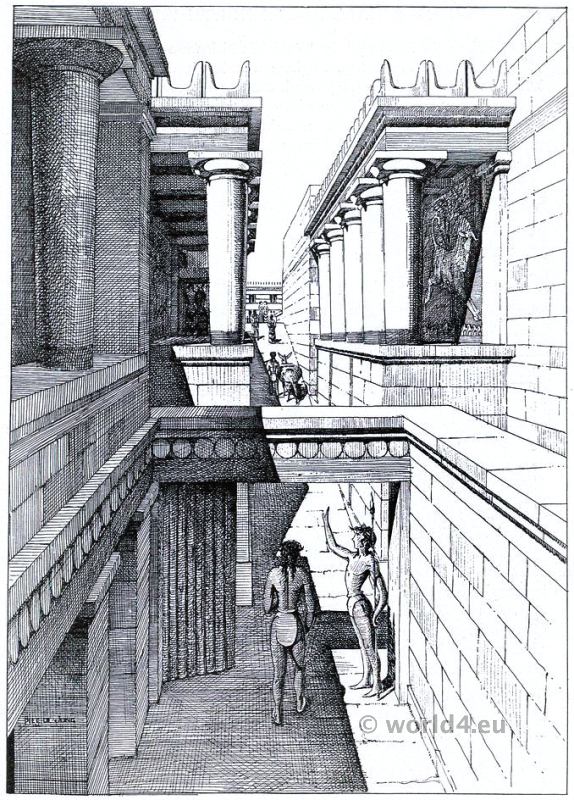
Long-robed Priestly and Royal Personages on Seals from Knossos and Vapheio.
Oriental Influences through Cyprus, on Cult of Dove Goddess—Syrian Axes.
The discovery of the Camp-Stool Frescoes on the borders of what on various grounds has been called the’Sanctuary Hall’, by the North-West projection of the Palace, brings them into very close relation with its central cult, so well illustrated by the noble ‘Palace Style’ jars and ‘amphoras’ derived from it, some of them exhibiting the sacred Double Axes and other ritual objects. At the same time the fact that the votaries of these wallpaintings are represented as holding chalices in precious metals may be taken to show that they belonged to the highest social rank. May the Hall itself have stood in a special connexion with some Sacral College, composed of young persons of both sexes belonging to the inner circle of the Court of the Priest-kings and including perhaps actual ‘Children of Minos‘? In any case the long-robed votaries of these frescoes stand in a close relation to the hierarchical system in vogue in the Palace in the last epoch of its history.
The exalted relationship in which we must place the personages of these frescoes lends a special importance to their exceptional dress covering the whole person, a form of costume which, as already pointed out, is entirely out of keeping with Minoan tradition. But, as will be shown, the exotic and unquestionably orientalizing character of these long robes fits in with other evidences of the intrusion during the last Palace period of other elements of an allied class from the same Eastern quarter. The intimate relations with Egypt were not broken off, but the Age in question undoubtedly corresponds with an epoch of renewed intensive influence from the Syrian side, recalling the cultural and religious wave which at the very beginning of the Age of Palaces had reached Crete from the Westwardly extended dominions of the founder of the First Babylonian Empire. In the present case we have largely to take into account the reactions of the growing connexion of the Minoan world with the, Syro-Anatolian regions through Cyprus, where the process of actual colonization was already beginning, and perhaps, indeed, in the wake of contemporary commercial plantations on the Mainland coast opposite to it.
Already, indeed, in the ‘Palanquin Fresco’, connected with the Entrance Corridor from the South, it seemed permissible to recognize the operation of this influence in the white-stoled ministers, whose vestments are distinguished by the dark band running down from the shoulder, and recalling the clavus of Roman and Etruscan usage. (See Fig. 332 a, b.)
The central figure of this composition, like those of the other fresco, similarly clad and seated on a folding stool, is borne aloft, and may well be identified with a Minoan Papa Rè in his sedia gestatoria. The oblique wrapping of these stoles also shows a distinct analogy with the robes depicted in the Camp-Stool Frescoes, and the general style of the designs, including the summary execution, marks, as already observed, more at less contemporary work. The ceremonial transport of the Priest-king” along this line of access has itself greatly gained in importance from the recent discover of the actual Temple Tomb of the House of Minos lying directly on the roadway that started from the foot of the Southern slope.
In a more general way the long robes of the votaries of the ‘Camp-Stool Fresco’ may also be compared with those of certain ‘gaberdined’ figures—there, too, of both sexes—seen in the ‘Procession Fresco’, and the similar costumes of the male and female ministrants engaged in the ritual scenes of the Hagia Triada Sarcophagus.
Seated Figure of Boy Votary
Long robes of the same kind were worn by male as well as female ministrants. Both the girl votary who pours the libations between the sacred Double Axes on the Hagia Triada Sarcophagus and the lyre-playing youth of the same ritual scene wear this dress, as well as another male figure from the later Palace there. The appearance of the lower borders of similar long robes on two male figures of the ‘ Procession Fresco’ has suggested their restoration as players, respectively, of the flute and lyre. We know that the Semitic lyre or kinnor is inseparable from the name of Kinyras, the Priest-king of Paphos, beloved of the Cyprian Goddess. ‘ As a seer and culture hero, beautiful and master of the lyre, he would naturally appear to the Greeks (who brought him into actual comradeship with Apollo) as a double of the Kitharoedos.’
Youthful personage holding dove
Intaglio showing Long-robed Youthful Personage holding Dove. The intaglio is cut on a green jasper bead-seal representing a thick elongated development of the ‘ amygdaloid ‘ class, and represents a long-robed youth holding a dove. The fringed appendage of the robe seen in Fig. 336, which falls down the back and connects itself with a short sleeve, presents a distinct parallel to the dress of the boy referred to belonging to the ‘Camp-Stool’ series above reproduced in Fig. 335, though in that case two fringed ends hang down presenting a wing-like appearance. The oblique position of the waist-band with a band below sloping in the opposite direction is also a recurring feature of conformity. The youth or boy seen in Fig. 336 has abundant locks of hair falling about his shoulders. The bird that he carries may naturally be regarded as an offering to a divinity, and there can be little doubt that it is intended to represent a dove. Though the neck is somewhat elongated, the bill, so far from being slightly upturned, as in the case of a duck, is definitely hooked at the point, like that of a pigeon. What is decisive, however, is the careful insertion of the swelling at the upper extremity of the bill well defined in the intaglio.
Archaeology: Palace of Knossos, Crete.
By Sir Arthur J. Evans. The Palace of Minos.
Online Resources:
- The palace of Minos: a comparative account of the successive stages of the early Cretan civilization as illustrated by the discoveries at Knossos – Evans, Arthur, Sir, 1851-1941. (Volume 1) (Volume 3)
- The Conservation of Archaeological Sites in the Mediterranean Region PDF. (An International Conference Organized by the Getty Conservation Institute and the Paul Getty Museum, 6-12 May 1995)
- Two Knights and a Goddess: Sir Arthur Evans, Sir James George Frazer, by Cynthia Eller (Keywords: Minoan Crete, Minoan religion, Arthur Evans, James George Frazer, goddesses, matriarchy, Jane Ellen Harrison)

